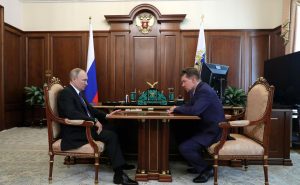Mongolia, geopolitically and physically land-locked between two regional powers — Russia and China — is paving the way to secure an energy alliance. In March 2020, Russian President Vladimir Putin met with Alexey Miller, Chairman of the Gazprom Management Committee on proceeding to the pre-investment phase in the Power of Siberia 2 project which involves Russia, Mongolia, and China. This mega-project could be a game-changer in the supply of gas to northeast Asia, with the construction of “1,942 kilometers of gas trunk lines with 114 wells.” While Russia’s energy pivot to Asia includes Mongolia, the government of Mongolia has been proactive in this pursuit and has sealed a Memorandum of Understanding (MOU) in 2019.
Russia’s state-owned Gazprom is one of the leading gas producing companies in the world. According to Miller, Gazprom has an annual capacity of doubling its current production, which at present stands at 545 billion cubic meters of gas. The calculated annual capacity then will supply to Russian consumers and partners — Mongolia and China. Russia in 2020 planned for investment totaling 1.080 trillion rubles ($14 billion).
The cozying of Russia-China relations not only involves securing energy in northeast Asia, but also opening opportunities for Mongolia to join the energy club. Considering both Russia and China are already Mongolia’s strategic partners, the Mongolian government is in a perfect position to pursue a proactive energy policy.
Mongolian Foreign Minister Tsogtbaatar Damdin said in an interview, “It took 30 years for Mongolia to be at the negotiation table on this matter. These efforts corroborate high-level visits, talks, and negotiations at a presidential, prime ministerial, foreign ministerial level. In order to build trust with both Russia and China, these steps were necessary and crucial.” Additionally, he highlighted that “the Russia-China pipeline project has begun, and Mongolia should not miss the opportunity to be part of its two neighbor’s initiation. Mutual trust and continuation of open dialogue and exchange of ideas between all three parties — Mongolia, Russia, and China are crucial at this point.”
During Prime Minister Col. Khurelsukh Ukhnaa’s state visit to Russia in December 2019, Mongolia and Russia signed a Memorandum of Understanding (MOU) on Mongolia’s participation in the Power of Siberia 2 pipeline mega-project. During the joint session, Putin affirmed that “Russia has no political opposition on pursuing this mega-project.”
In March 2020, Miller stated, “With the aforementioned resource base, our domestic gas supplies can fully satisfy the needs of these constituent entities of the Russian Federation. And as for the instruction to explore the possibilities for transiting gas to China across Mongolia via Power of Siberia 2, I can report that the number of supplies via this route may total up to 50 billion cubic meters per year. We are ready to continue this work accordingly.”
In northeast Asia, Russia-China energy relations have already begun. In December 2019, the first pipeline built by Gazprom, as Nikkei Asian Review reported, “runs from reserves in eastern Siberia to the border region in northern China. Gas started flowing in a 2,200km portion of the link from the gas field north of Lake Baikal. The pipeline stretches 3,200 km, with shipment capacity reaching 38 billion cu. meters a year, or about 20% of China’s annual liquefied natural gas imports.”
In pursuit of this mega-project, the Mongolian government has been keen and active. A Mongolia-Russia task force has been established to share project related information. The second level of studies will involve Mongolia’s participation which heavily involves gas pipeline routes.
Mongolia’s participation in the Power of Siberia 2 project will make Mongolia a transit country in the Russia-China supply chain of gas in northeast Asia. Mongolia’s foreign policy toward both Russia and China, bound by strategic partnerships, has proved to be useful. Some security analysts emphasize Mongolia’s growing dependency on the neighbors for fuel and power as a national security threat as Russia supplies 92 percent of Mongolia’s demand. In a counterargument, from foreign policy and geopolitical standpoint, Mongolia, by not participating in the “energy club” of its only neighbors, will damage its opportunities and capabilities immensely. Moreover, an important aspect of oil and gas cooperation within Russia-Mongolia-China trilateralism aims to expand geological surveys to further explore hydrocarbon fields in Mongolia.
Amid the COVID-19 pandemic in Mongolia, in March, a meeting at the National Security Council (NSC) of Mongolia concluded a working group headed by Deputy Minister Enkhtuvshin U. will be set up under the NSC. The next step of the trilateral agreement will involve the legal environment along with construction, architectural, and engineering planning. China National Petroleum Corporation (CNPC) will be Mongolia’s main liaison to this project. If implemented without any hurdles, the Power of Siberia 2 project will diversify Mongolia’s energy sector, reinvigorate its — much slow downed — foreign direct investment sectors, and create up to 4,000 jobs.
Bolor Lkhaajav received an M.A. in Asia-Pacific Studies from the University of San Francisco. She is currently writing a book on the international affairs of Mongolia. Bolor is Co-host of 77 Podcast based out of Washington DC.

































